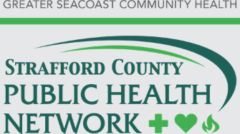
The Strafford County Public Health Advisory Council recently released a three-year Community Health Improvement Plan. From left are: Marc Hiller, UNH Department of Health Management and Policy; Betsey Andrews Parker, Community Action Partnership for Strafford County; Mary Ellen Gourdeau, American Ambulance/Ready Strafford; Mary Wilson, SAU 64 Milton; Anne Grassie, Rochester Child Care Center; Janet Laatsch, Goodwin Community Health; Dean LeMire, ONE Voice for Strafford County; Mollie Behan, Strafford County Public Health Network; Tracey Collins, Frisbie Memorial Hospital; Liz Clark, Strafford County Public Health Network; Michelle Hanson, Wentworth-Douglas Hospital; and Liz Durfee, Strafford Regional Planning Commission. Photo/Courtesy
By John Doyle
jdoyle@fosters.com
Posted Feb. 15, 2016 at 4:10 PM
Updated Feb 15, 2016 at 6:06 PM
SOMERSWORTH — Strafford County ranks eighth out of 10 New Hampshire counties for overall health outcomes, a statistic one advocacy group wants to change.
The Strafford County Public Health Advisory Council Network has released a three-year Community Health Improvement Plan (CHIP), a systematic, county-wide plan that summarizes the health of the county, assesses gaps and assets, and recommends evidence-based solutions to address the county’s most pressing public health issues.
“It’s the first-ever health improvement plan for Strafford County,” said Melissa Silvie, director of public health and continuum of care coordinator at Goodwin Community Health in Somersworth. The two hospitals in the county (Frisbie Memorial in Rochester and Wentworth-Douglass in Dover) each embark on a health-improvement plan every three years, but just in their own backyards. The new health improvement plan encompasses all 13 Strafford County communities and the University of New Hampshire to cover the entire region, Silvie said.
Strafford County is ranked behind Rockingham, which includes Portsmouth, Greenland, Hampton, New Castle and Newmarket. It is also ranked below Grafton, Merrimack, Belknap, Hillsborough, Cheshire and Carroll counties and ahead of Sullivan and Coös counties in overall health outcomes. The data represents how healthy counties are within the state. Strafford was ranked ninth in 2014.
Silvie said one reason for Strafford County’s overall health being among the worst in the state has to do with economic disparity.
“If you look at pockets of poverty in Strafford, it’s literally haves and have-nots,” Silvie said. “Farmington, Milton and Rochester are only 10 miles from Durham, Lee and Madbury, but there are social determinants — college degrees. It’s really that simple. Those are the kinds of things that affect public health.”
Other concerning Strafford County health findings include: a 31 percent adult-obesity rate; the highest rate for hospital admissions attributable to stroke; less than one-third of residents reporting being prepared for a wide-scale disaster or emergency; and a high overdose rate.
The plan will focus on five top priorities: substance misuse (prevention, treatment and recovery); mental health; obesity and nutrition; emergency preparedness; and heart disease and stroke. According to Silvie, substance misuse and emergency preparedness are two priorities mandated by the state, but it soon became apparent to the council that substance misuse was clearly a top priority regardless.
Each of the priority areas were assigned goals, objectives, measures and evidence based strategies that will be used as guidelines for area organizations and community stakeholders to improve health in the county. A few of the initiatives selected in the CHIP are already in the making, including creating a recovery community center for those suffering from addiction and strengthening coordination with hospitals and human service organizations to better align resources.
Silvie said New Hampshire is one of the healthiest states in the country, but ranks 49th out of 50 (ahead of Texas) in access to health treatment.
“In the 1980s, New Hampshire was hailed as one of the best states as far as mental-health services,” she said. “Now we’re one of the worst. We’ve systematically broken down systems in place for substance-abuse treatment.”
To successfully implement the CHIP, strategic initiatives have been outlined for each priority area. They can be viewed on the council’s website, www.scphn.org. For obesity and nutrition, initiatives include increasing access to free and low-cost physical-activity opportunities.
For heart disease and stroke, initiatives include implementing the U.S. Department of Health and Human Services’ “Million Hearts” campaign to save one million lives in five years through heart-health education.
For substance misuse, initiatives include creating a recovery center that will house local resources for youth and adults in the county.
Link to access this Fosters article: http://www.fosters.com/article/20160215/NEWS/160219603/14436
